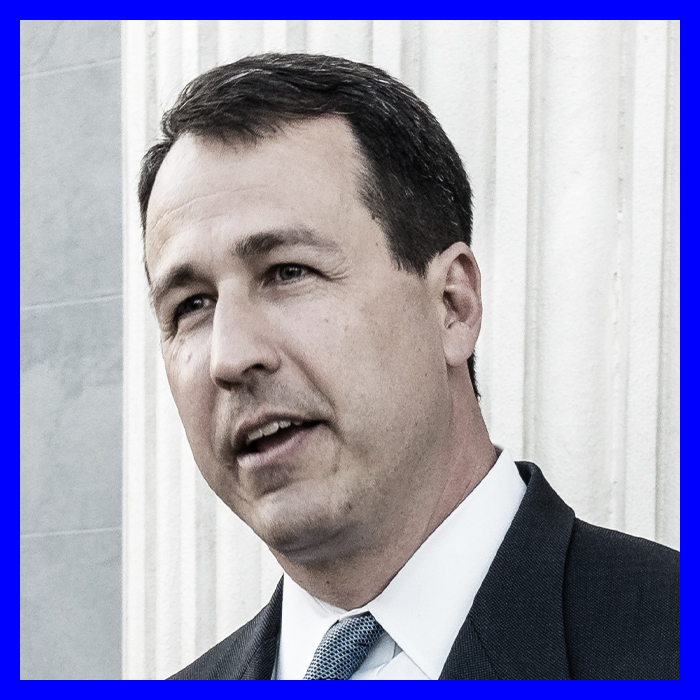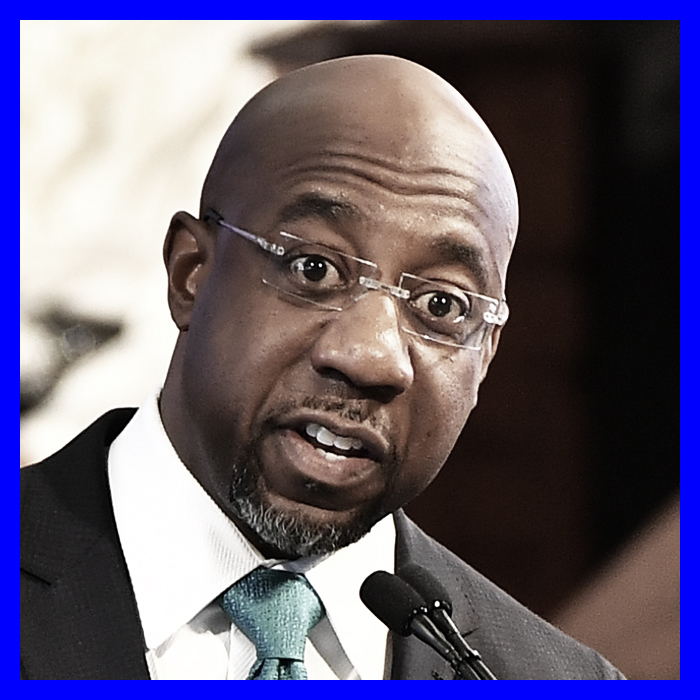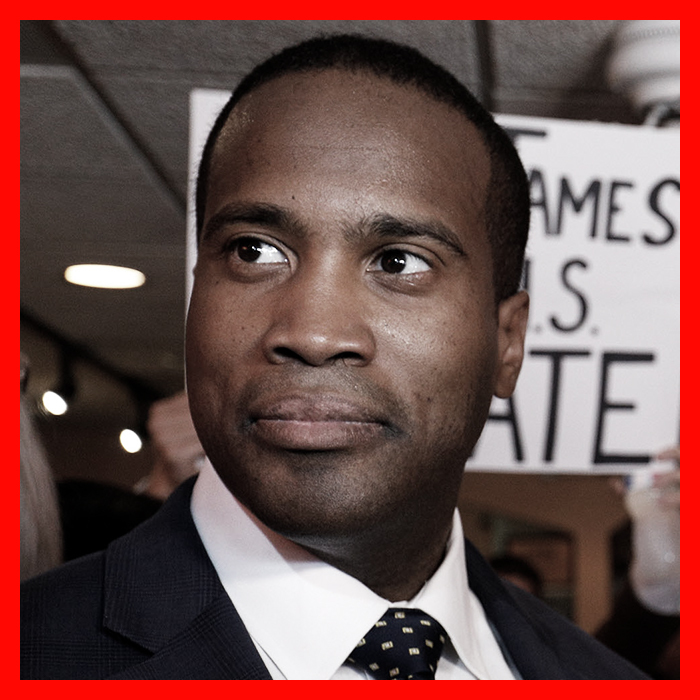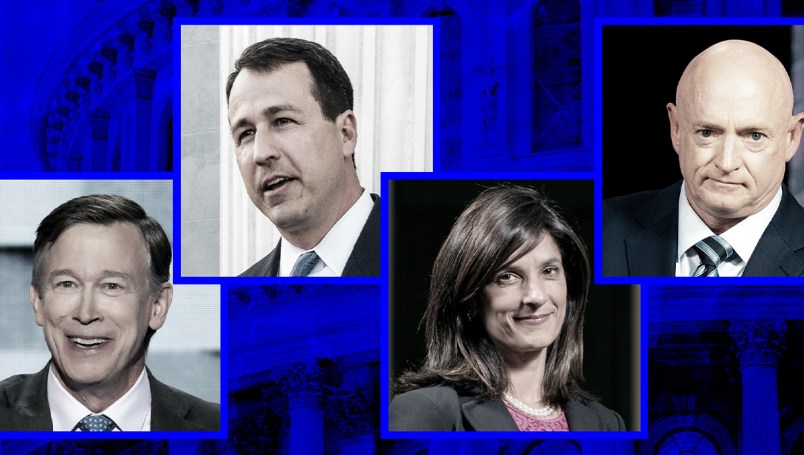With just 14 days to go until the election, Democrats have a good shot at retaking the Senate.
FiveThirtyEight currently has Democrats “favored” to win the chamber with a 75 percent chance. The Economist’s model similarly calls a Democratic triumph “likely” at 76 percent.
Heading into the campaign cycle, Democrats were already well-positioned by only having to defend 12 seats to Republicans’ 23. And while other reasons for Democrats’ advantages vary by state, two throughlines connect many of the races: the party recruited candidates who fit the state well, and President Donald Trump’s unpopularity threw races into contention in which Democrats normally have no business competing.
Currently, Republicans control the Senate with a 53-to-47-seat edge. That means Democrats need a net gain of three seats plus the White House, or four seats without, to get a bare majority. This will likely also entail picking up an extra seat to achieve that net gain, since Sen. Doug Jones’ (D-AL) odds are long this time around.
Just A Blue Splash ?
These four states represent Democrats’ easiest path to Senate control.
Colorado

Incumbent Sen. Cory Gardner (R-CO) is defending his seat against John Hickenlooper, the state’s governor from 2011-2019 who had a brief, unsuccessful presidential run this cycle. This is one of two states Republicans are defending that Hillary Clinton won in 2016, and it’s trending bluer and bluer.
Gardner is trying to execute the unenviable task of keeping conservative Coloradans in his pocket while breaking with Trump enough to pick up swingier voters. In a sign of how that tightrope walk is going for him, a top Democratic PAC aligned with Senate Minority Leader Chuck Schumer (D-NY) pulled out of the state this week, confident enough that Hickenlooper will win to spend that money elsewhere.
Gardner is trying desperately to keep the race local, to prevent it from becoming a referendum on Trump. He’s been highlighting his bipartisan appeal, and touting his work on issues like health care. But the latter earned him a raft of negative local headlines last month, when he ran a campaign ad that had a misleading claim about protection for those with preexisting conditions in a health care bill he put forward. Hickenlooper hasn’t run the perfect race either. He made two unforced errors during the primary: being found to have violated state gift laws by taking rides in a private jet and Maserati limo while governor, and having to apologize when comments he made in 2014 were unearthed comparing being a political scheduler to the slave trade. Still, Hickenlooper has been consistently ahead in the polls for months, and Colorado is a likely Democratic pick-up.
Arizona

Incumbent Martha McSally (R-AZ) is trying to fend off an aggressive challenge by Mark Kelly, a former astronaut and gun control activist who is married to former Rep. Gabby Giffords (D-AZ). McSally lost to Sen. Kyrsten Sinema (D-AZ) in 2018, but was appointed by Gov. Doug Ducey (R) to fill the seat vacated by the late Sen. John McCain (R-AZ). The current election will decide who will serve out the last two years of McCain’s term.
Kelly has proven to be a fundraising juggernaut, and has been polling ahead of McSally for months. New polls, released in recent days, tell the same story: Monmouth University has Kelly up 10, Reuters/Ipsos has him up 11 and CBS News/YouGov has him up 11. McSally has struggled to get out from under negative favorability ratings and, per the new Monmouth poll specifically, continues to do poorly with voters over 65. The older voter bloc is a crucial Arizona demographic, and her failure to win it over is a possible repercussion of her full-fledged commitment to Trump amid the pandemic.
North Carolina

Sen. Thom Tillis (R-NC) is taking on Cal Cunningham, an Iraq War veteran and former state senator, in what could become the most expensive race in Senate history. Democrats have long smelled blood in the water in this swingiest of states, after Tillis eked out his first Senate win in 2014 by only 46,000 votes — less than one percentage point.
With the suburbs ringing Raleigh, Durham and Charlotte becoming increasingly Democratic, Cunningham has (mostly*) been running a campaign with disciplined focus on health care: namely, expanding Medicaid and improving the Affordable Care Act. He has been hitting Tillis for his time in state government, where he opposed expanding Medicaid and worked to reduce state employment benefits.
*I say mostly, because this race got a double-whammy October surprise at the same time that Trump’s positive COVID-19 diagnosis was exploding into the news. Tillis, who attended the Rose Garden super spreader event earlier this month, confirmed that he too had contracted the infection. But hours later, Cunningham confirmed the veracity of sexual texts sent between him and a woman who is not his wife during the campaign. Still, according to recent polls, the race hasn’t changed a whole lot. Three polls put into the field after the scandals from Monmouth, Morning Consult and WRAL show Cunningham up by four, six and 10 points respectively.
Maine

Incumbent Sen. Susan Collins (R-ME), one of the last Republican holdouts in New England, is in the fight of her life against state speaker of the House Sara Gideon. Maine is the second state Republicans are defending that went to Clinton in 2016.
Collins’ winning brand as an independent-minded moderate has taken serious dings in the Trump era with Democrats still seething over her votes in favor of the 2017 GOP tax bill, to confirm Supreme Court Justice Brett Kavanaugh and to acquit Trump during the impeachment trial.
Logistically, Collins is also likely wary of her first election since the state adopted ranked-choice voting, which took out the last Republican U.S. House member from New England in 2018. If no candidate tops 50%, lowest-ranked candidates are systematically eliminated until there’s a winner — making the second-place vote of people voting for third party or independent candidates very important.
A recent poll from Portland-based Pan Atlantic Research showed Gideon up 7 points, while a Bangor Daily News/Digital Research poll released last week showed Gideon up by one. September polls have Gideon up anywhere from one to 12, and FiveThirtyEight rates her “slightly favored” to win.
A Blue Wave ??
These races could go either way, depending on factors like turnout. But if we see a Democratic wave à la 2018, these Senate seats are more likely to drop into the blue bucket.
Iowa

Freshman incumbent Sen. Joni Ernst (R-IA) is trying to fend off real estate developer Theresa Greenfield in what has become a shockingly close race. Ernst rode into the Senate in 2014 on a wave of expectation, after easily dispatching her weak Democratic opponent. She has recently seen her fate falter, as Trump’s popularity plummets in the state, possibly even putting it into contention for the presidential race. Ernst, who has embraced Trump, is suffering from those coattails.
Greenfield has run a disciplined campaign targeting Ernst on pocketbook issues like health care and strengthening Social Security. She has a compelling personal story to help sell that emphasis, as her husband was killed on the job and she raised her young family on Social Security benefits. Daughter of a crop duster, she has emphasized her farm girl roots, a tried and true strategy in the state that Ernst also deployed successfully in 2014 (“I grew up castrating hogs on an Iowa farm”). Greenfield has also aired ads featuring Republicans vouching for her.
Ernst didn’t help her cause with a debate stumble so bad it rated national headlines, when she flubbed the cost of soybeans last week after Greenfield nailed the cost of corn. A batch of polls this month showed Greenfield up by three to five points.
Georgia (Special)

In the weirdest race in the cycle, a whole batch of candidates is vying to fill Sen. Johnny Isakson’s (R-GA) seat, all of whom will be on the ballot on November 3. That includes Sen. Kelly Loeffler (R-GA), who was appointed to fill the seat on an interim basis, Rep. Doug Collins (R-GA) and Democrat Rev. Raphael Warnock. If none of them get more than 50 percent, the top two go to a January 5 runoff.
Warnock has been consistently leading the polls, by anywhere from four to 19 points this month, but polling doesn’t capture the full picture here. Republican support is likely being split between Loeffler and Collins — both of whom have hitched themselves securely to Trump’s wagon, and are probably suffering accordingly in a suddenly competitive state — in a way that it won’t be if Warnock can’t surpass 50 percent but ends up in a runoff with one Republican opponent and no Biden atop the ticket to drive turnout.
Democrats have had near misses in the state recently (think Stacey Abrams in 2018), but did flip the sixth district, won by Rep. Lucy McBath (D-GA), the same year. Still, Democratic hopes may be stymied again by the state’s historic and ongoing voter suppression — we’ve already seen enormous early voting lines, mirroring those that snaked across the state’s metropolitan areas in the primaries.
Montana

Similarly to Colorado, Democrats did well in Montana to recruit Gov. Steve Bullock (D) to challenge Sen. Steve Daines (R-MT) after an unsuccessful presidential bid, turning a safe Republican hold into a competitive race. Bullock was a popular governor, and has emphasized his cooperation with Montana’s Republican legislature. Daines has been loyal to Trump and largely stayed under the radar.
While Daines may have the slight edge in the red state, Montana’s independent streak makes it winnable for the Democrats. It elected Trump by more than 20 points in 2016, but also reelected Bullock. Montanans also reelected Sen. Jon Tester (D-MT) two years later, despite an all-out attempt by Republicans to unseat him.
The undermining of the postal service has been a hot issue in the rural state, with Bullock suing Postmaster General Louis DeJoy and Daines pushing for emergency aid. Montana is relatively hard to poll, but a recent batch shows the two candidates flipping back and forth with one to two-point leads. A competitive gubernatorial and U.S. House race here is also attracting eyeballs and money.
A Blue Tsunami ???
Many of these races are closer than expected, though in states Democrats usually don’t win. Still, if this election sees ceiling-shattering turnout and a Biden rout, some of these races could be on the table.
Georgia

In Georgia’s other Senate race, Sen. David Perdue (R-GA) is running against Jon Ossoff, who mounted a competitive and expensive congressional race in 2017. Like the other Georgia race, state dynamics are very much in play with an influx of transplants and increasingly purple suburbs making the race close on both the Senate and presidential level.
Perdue has been accusing Ossoff of hiding his “radical socialist agenda,” and has run false ads in the state accusing Ossoff of wanting to defund the police and getting support from the Communist party. Ossoff has marched with Black Lives Matter protesters and is trying to turn out new Black voters. He has also accused Perdue of complicity with Trump’s bungled COVID-19 response.
Perdue stepped into a scandal last week, when he mockingly mispronounced Sen. Kamala Harris’ (D-CA) name (“Kamala-mala-mala? I don’t know. Whatever.”) at a Trump rally. Later, amid furious blowback to the racist joke, he claimed that he actually didn’t know how to pronounce his Senate colleague’s name. The Ossoff campaign raked in a windfall of donations afterwards. It’s not the first time Perdue has been in hot water over a bigoted tactic this cycle: in July, his campaign had to pull a Facebook ad that featured Ossoff, who is Jewish, with an altered and enlarged nose.
Polls of this race have been all over the place this month, with a recent Quinnipiac University one showing Ossoff up by six, but others giving Perdue a single-digit edge. A New York Times poll released Tuesday shows a draw.
South Carolina

Longtime Senate feature and, more recently, staunch Trump ally Sen. Lindsey Graham (R-SC) is in a surprisingly close race against former chair of the state Democratic Party Jaime Harrison. Harrison overcame an early 15-point deficit and proved to be a formidable fundraising force, recently bringing in an eye-popping $57 million in one quarter, shattering the record set by Beto O’Rourke in 2018.
Graham, who has previously cruised to reelection, may also be being dragged down by his tight ties to Trump. Few polls have shown the President recreating his 2016 14-point landslide here.
Harrison, like many of his Democratic challenger peers, is working from the health care playbook, focusing particularly on Medicaid expansion. He has also gone after Graham for his personal hypocrisy by cutting ads highlighting the senator’s old comments on Trump and whether or not it was acceptable to fill a Supreme Court seat during an election year. Graham, meanwhile, has been emphasizing his role in shepherding Supreme Court nominee Amy Coney Barrett onto the bench.
The only October poll, from the New York Times, shows Graham up six points. A Quinnipiac one in late September had the race tied.
Kansas

Kansas is in play in part because an open seat is easier to win — Sen. Pat Roberts (R) is retiring — and in part because Barbara Bollier, a former state senator and moderate Republican who switched parties in 2018, is the kind of Democrat that stands a chance. She’s up against former U.S. Rep. Roger Marshall (R-KS), who national Republicans bolstered aggressively to beat Kris Kobach in the primary. The common wisdom was that Kobach, a controversial and inflammatory figure who spearheaded Trump’s useless voter fraud task force, would put the seat at risk.
There has not been a ton of polling in the state recently, though the September batch showed everything from a draw, to a slight Bollier lead to a seven-point Marshall lead. In a sign of Republican unease, a PAC aligned with Senate Majority Leader Mitch McConnell (R-KY) poured $5 million into the race as recently as last month. A Schumer-aligned PAC jumped into the fray earlier this month with a $7.5 million investment.
Though Kansas is deeply red, the GOP brand has taken some hits recently, with the deep unpopularity of former Gov. Sam Brownback’s (R) tax and government program cuts, and Kobach’s attempts to make it harder to vote. The state’s dissatisfaction with the far-right has been reflected in Democratic successes, as Democrat Laura Kelly became governor in 2018 and Rep. Sharice Davids (D-KS) became the state’s first Democratic U.S. House member since 2010. Still, it’s Kansas — if Bollier wins, she’d be the first Democrat to win a Senate race since 1932.
Alaska

Sen. Dan Sullivan (R-AK) is fending off a surprisingly competitive challenge from orthopedic surgeon and commercial fisherman Al Gross, a registered independent who ran for and won the Democratic nomination. Sullivan won the seat narrowly in 2014, by fewer than 8,000 votes.
The race has attracted attention and money recently, as polling shows it to be closer than expected. That being said, Alaska is notoriously hard to poll, and a recent New York Times one has Sullivan up by eight.
While Sullivan is likely favored to win, Alaska has the highest number of independent voters of any state, and they’ve proven their willingness to swing before. Democrats won this seat in 2008 (granted, the incumbent Republican had been convicted on felony corruption charges) before losing it in 2014. Here Sen. Lisa Murkowski (R-AK) was also able to win a write-in campaign, after losing the Republican nomination.
A recent local scandal is also throwing the race into flux. A watchdog group recorded conversations between actors posing as investors and the heads of the companies behind Pebble Mine. Pebble Mine, a project that most Alaskans (including Gross) disapprove of, would open up Bristol Bay to large-scale mining. Critics say it will threaten the salmon fishery there, which will hurt the wildlife, industry and tribes that depend on it. Sullivan, who has taken campaign contributions from mine executives, had remained on the fence about the mine during the race, but the tapes revealed the executives hinting that his camp would come around to the project after the election.
Texas

Texas, Democrats’ longtime white whale, has seen both its Senate and presidential race tightening. Sen. John Cornyn (R-TX) is holding off MJ Hegar, an Air Force veteran who ran a buzzy, though ultimately unsuccessful, 2018 House race.
Democrats have come tantalizingly close to Senate victory with O’Rourke’s 2018 bid, but haven’t yet struck gold. Cornyn is less polarizing than Cruz, but is clearly worried about the drag of his proximity to Trump based on recent comments comparing their relationship to a bad marriage. All of the recent polls show Cornyn up, though a Public Policy Polling one from last week gives him only a three-point edge.
Republican Pickup Chances
Alabama

Jones, previously mentioned as Republicans’ best pickup opportunity, is waging an uphill battle. Trump’s net approval rating is higher in Alabama than anywhere else, and Jones hasn’t broken with the party on big anti-Trump votes like impeachment and the Kavanaugh confirmation. Jones was only able to pick off the seat in 2017 because Roy Moore, embroiled in accusations of preying on underage girls, was a historically bad candidate.
Republicans expect to right the ship with former Auburn football coach Tommy Tuberville, no matter that Tuberville had to bat back fraud accusations connected to a hedge fund he ran. Public polling shows a yawning gap in Tuberville’s favor, though the Jones campaign says that its internals reflect a much closer race.
Michigan

Republicans’ only other real shot at a pickup is by knocking out unassuming incumbent Sen. Gary Peters (D-MI), who is running against challenger John James. James is a Black businessman who unsuccessfully challenged Sen. Debbie Stabnow (D-MI) in 2018.
Though Trump narrowly won the state in 2016, polls show Biden comfortably up this time around. Peters has been consistently polling ahead, though not always by much: a New York Times poll from earlier this month set Democratic alarm bells ringing when it showed Peters up by only one point. Former President Barack Obama, who recently put out a series of ads for Democratic challengers, cut one endorsing Peters that started airing this week.
Correction: This post initially referenced the “late Sen. Johnny Isakson’s (R-GA)” who is, in fact, not late at all; he retired in 2019. TPM regrets the error.







Come January, I hope to never, ever, have to hear another goddamn peep about “concerns” from Susan Collins. So much veneered bullshit.
Can we, please gawd, not have any more protests or burnings or violence that can possibly be pinned on Antifa or the left? Remove all doubt, stay off the streets, don’t let yourself get provoked, and the only mobilizing we should be doing is voting. No need to provide an Oct. Surprise Own Goal. Joe and Kamala got this.
I would have included the Kentucky race in the Blue Tsunami section. 538 has this seat as pretty solid for McConnell, but its been lightly polled with the last coming in Mid-September.
If the bottom is dropping out for Trump and the GOP, this is exactly the type of sleeper that could flip to D without people expecting it. Mississippi or Tennessee could also potentially fall into this zone.
I would like to think that running a charity that spends all its money on entertainment, legal and consulting expenses, and a brand new pickup truck, instead of giving it to veterans’ causes like it’s supposed to be doing, would be seen as bad even in Alabama. We’ll see.